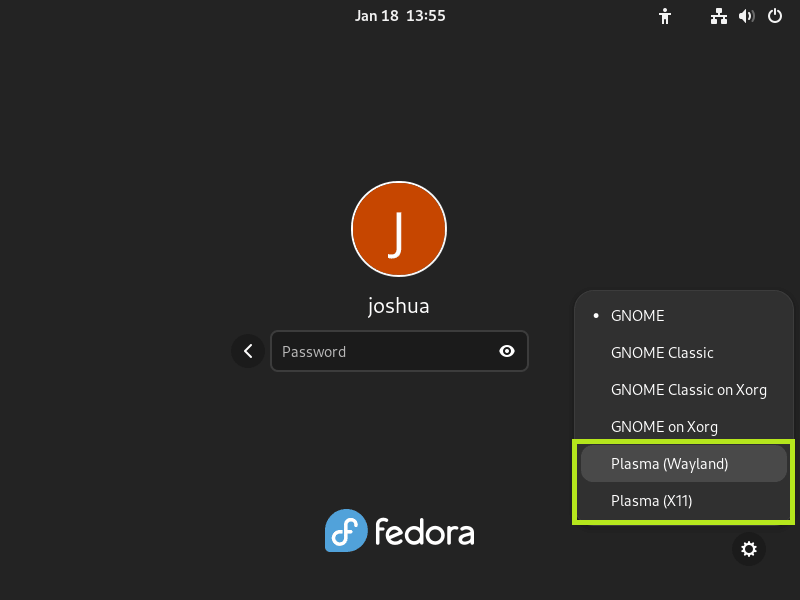KDE Plasma provides a highly customizable desktop environment with modern aesthetics, powerful widgets, and deep integration with KDE applications. Whether you prefer keyboard-driven workflows, visual customization through themes and panels, or a feature-rich file manager with Dolphin, Plasma delivers a polished experience suitable for both daily productivity and creative work. By the end of this guide, you will have KDE Plasma installed on Fedora with the SDDM display manager configured, ready to switch between Wayland and X11 sessions at login.
If you prefer a pre-configured KDE experience without installing over an existing Fedora Workstation, consider downloading the Fedora KDE Spin, which ships with Plasma as the default desktop environment.
Update Fedora Before Installing KDE Plasma
Before installing new software, updating your system ensures all packages are current and prevents potential dependency conflicts. This step refreshes repository metadata and applies any pending security patches.
Run the following command to update your system:
sudo dnf upgrade --refreshAfter the upgrade completes, proceed with the KDE Plasma installation.
Install KDE Plasma via DNF Command
Fedora provides KDE Plasma through a package group that includes the desktop environment, essential applications, and the SDDM display manager. First, you can preview what the group contains before installing:
dnf group info "KDE"Expected output (truncated):
Id : kde-desktop
Name : KDE
Description : The KDE Plasma Workspaces, a highly-configurable graphical user interface...
Mandatory packages : plasma-desktop
: plasma-workspace
: sddm
: sddm-breeze
: sddm-wayland-plasma
Default packages : dolphin
: konsole
: kwrite
: spectacle
: ...
This output shows the mandatory and default packages included in the KDE group. Once you are ready to proceed, install the complete KDE Plasma environment:
sudo dnf groupinstall "KDE" -yThe -y flag automatically confirms the installation prompt. If you prefer to review the package list before proceeding, omit this flag. The installation downloads several hundred megabytes of packages and may take several minutes depending on your connection speed.
If you are interested in learning more about DNF5 group commands, see our guide on DNF5 group commands on Fedora.
Reboot to Complete Installation
After the installation completes, a system restart is necessary to switch from GDM (GNOME Display Manager) to SDDM and load the new desktop environment. Reboot using the GUI or run the following command:
sudo rebootUpon restart, the system will boot into SDDM instead of GDM, presenting the Plasma login screen.
Select KDE Plasma at Login
After rebooting, you will see the SDDM login screen. By default, the system may still attempt to load your previous session, so you need to select Plasma manually for the first login.
Choose Your Display Server Protocol
Fedora offers both Wayland and X11 sessions for KDE Plasma. At the login screen, click the session selector (usually a dropdown or gear icon in the bottom-left corner) to choose between:
- Plasma (Wayland): The modern display protocol with improved security, better HiDPI support, and smoother animations. This is the recommended choice for most users with recent hardware.
- Plasma (X11): The traditional display server with broader application compatibility. Choose this if you use older applications, certain remote desktop tools, or encounter Wayland-specific issues.

For users with NVIDIA graphics cards, you may experience better stability with the X11 session until NVIDIA Wayland support matures. See our guide on installing NVIDIA drivers on Fedora for GPU configuration details.
Verify Installation
After logging in, open a terminal (search for “Konsole” in the application menu) and verify the Plasma version:
plasmashell --versionExpected output:
plasmashell 6.5.4
The version number confirms that KDE Plasma is installed and running. You can also verify your current display server with:
echo $XDG_SESSION_TYPEThis returns either wayland or x11 depending on your session choice:
wayland
Manage KDE Plasma
Update KDE Plasma
KDE Plasma updates arrive through Fedora’s standard package management. To keep your desktop environment current with the latest features and security patches, run regular system updates:
sudo dnf upgrade --refreshThis command updates all system packages, including Plasma components. For more control over automatic updates, consider configuring DNF Automatic on Fedora.
Remove KDE Plasma
If you decide to return to GNOME or switch to a different desktop environment, you can remove KDE Plasma completely.
Warning: Removing KDE Plasma deletes all Plasma-specific settings and configurations, including customized panels, widgets, and application preferences stored in
~/.config/. If you want to preserve these, back up the directory first withcp -r ~/.config ~/config-backup.
First, log out of Plasma and switch to a GNOME session at the login screen. Then open a terminal and remove the KDE group:
sudo dnf groupremove "KDE" -yAfter removal, clean up any orphaned dependencies that were installed alongside KDE:
sudo dnf autoremove -yFinally, reboot to return to GDM and the GNOME desktop:
sudo rebootTroubleshoot KDE Plasma Installation
Plasma Session Does Not Appear at Login
If the Plasma session option does not appear in the SDDM session selector, the display manager may not have switched correctly. First, check which display manager is currently active:
systemctl status display-managerIf GDM is running, the output will show:
● gdm.service - GNOME Display Manager
Loaded: loaded (/usr/lib/systemd/system/gdm.service; enabled; ...)
Active: active (running) since ...
If SDDM is correctly configured, you will see sddm.service instead. When GDM is still active instead of SDDM, manually set SDDM as the default:
sudo systemctl disable gdm
sudo systemctl enable sddm
sudo rebootBlack Screen After Login
A black screen after selecting Plasma often indicates a graphics driver issue, particularly with NVIDIA hardware on Wayland. Try logging into the Plasma (X11) session instead. If that works, your graphics driver may need configuration for Wayland support.
To switch sessions without a graphical interface, press Ctrl+Alt+F3 to access a TTY, log in, and install the X11 session support if missing:
sudo dnf install plasma-workspace-x11 -y
sudo rebootSDDM Fails to Start
If the system boots to a command line instead of the graphical login, SDDM may have failed. Check its status:
systemctl status sddmIf SDDM shows errors, review the logs for details:
journalctl -xeu sddmCommon causes include missing graphics drivers or conflicting display manager configurations. Reinstalling SDDM often resolves configuration issues:
sudo dnf reinstall sddm sddm-breeze -y
sudo systemctl enable sddm
sudo rebootConclusion
You now have KDE Plasma running on Fedora with both Wayland and X11 sessions available at login. From here, you can customize the desktop through System Settings, install additional KDE applications from the Fedora repositories, or explore the built-in widgets and panel configurations. If you encounter graphics issues on Wayland, the X11 session provides a stable fallback. For users exploring alternative desktop environments, Fedora also supports Xfce as a lightweight option.


